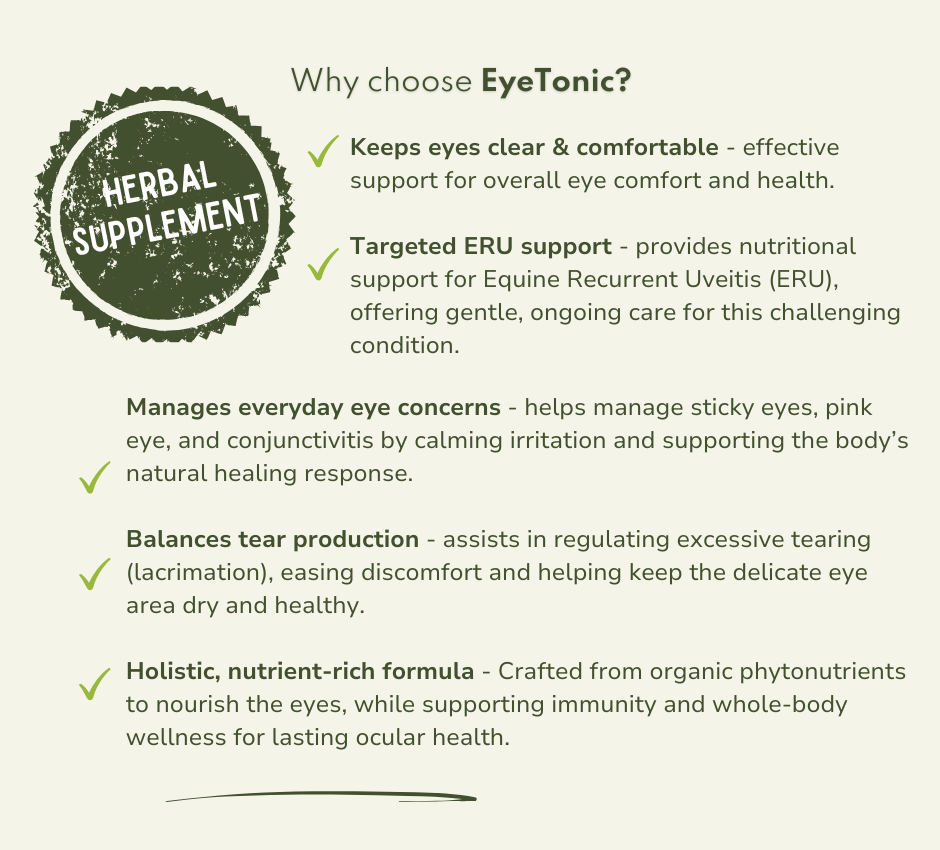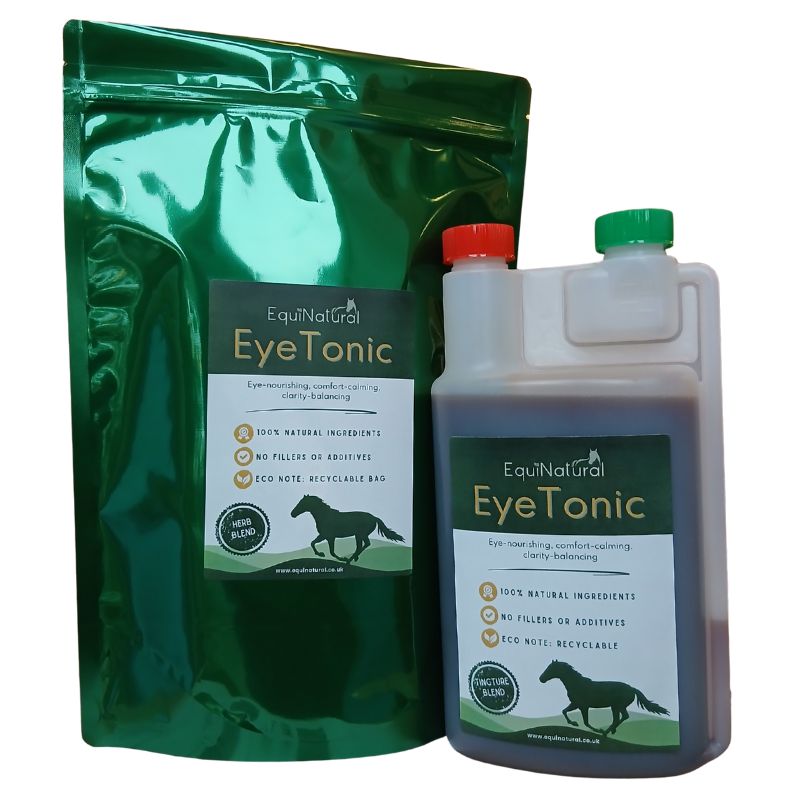EYETONIC *Organic herbal blend for horses - eye-nourishing, comfort-calming, clarity-balancing
Nurture your horse’s eye health naturally with EyeTonic - gentle, restorative support for sensitive or challenged eyes.
A carefully formulated blend of organic botanicals, EyeTonic nourishes the delicate ocular tissues from within - easing irritation while supporting microcirculation, immune balance, and clearer, calmer eyes over time.
Whether your horse struggles with recurring irritation, seasonal flare-ups, or deeper, long-standing sensitivity, EyeTonic brings steady, natural support where it’s needed most.
*Particularly helpful for horses prone to Equine Recurrent Uveitis (ERU).
✨ “The specialist was amazed - virtually all signs of ERU gone, and even a cataract had shrunk!”

Overview
The equine eye is the largest of any land mammal, and a beautiful thing to behold.
Beautifully complex and deeply expressive, they're a true mirror of your horse’s inner wellbeing. It's no surprise that Traditional Chinese Medicine (TCM) describes the eyes as "the windows to the inner workings of the body".
EyeTonic was born from our own experience. We originally created this blend for our Cookie, who struggled with sticky eyes every winter and again in pollen season. Later, little Pops arrived with chronic tearing and pink, irritated eyes that crusted over each day. Nothing held long enough to help - masks, wiping, you name it. She was constantly rubbing, making things worse.
Within 24 hours of starting EyeTonic, the tearing had eased; within a few days, she was clearly more comfortable, and from then on, she never looked back.
Rooted in functional herbalism, EyeTonic supports the deeper systems that influence eye comfort: circulation, immune tone, antioxidant protection, and detox balance - helping your horse stay clear-eyed and comfortable through the seasons.
For the latest equine eye health insights, see our main A-Z Condition/Eyes page in the Advice Centre above.
Is EyeTonic Right for Your Horse?
EyeTonic is designed for horses who need gentle, ongoing nourishment for ocular comfort, microvascular support, and immune balance - especially those with sensitive, reactive, or chronically challenged eyes.
It helps maintain calm, hydrated, resilient ocular tissues by supporting:
- the microcirculation that feeds the eye
- natural immune balance
- the detox–lymph–liver pathways that influence ocular comfort
EyeTonic is helpful for horses with:
- recurring irritation, tearing, or light sensitivity
- seasonal flare-ups linked to pollen or dust
- microvascular resilience and antioxidant protection
- deeper, long-term ocular challenges (including ERU-prone horses)
Composition & Feed Guide
Each herb in EyeTonic plays a protective and regenerative role in supporting ocular and systemic wellbeing.
This synergistic blend nourishes circulation, strengthens capillary integrity, and helps maintain clear, comfortable eyes through natural antioxidant and microvascular support.
EyeTonic is a nutritional food supplement and not veterinary medicine. For more on this, see Dr Kellon's article - Nutrition is not 'Alternative' Therapy.
Herbal Glossary
- Astragalus membranaceus – Cellular immune resilience; supports delicate ocular tissues against oxidative stress.
- Taraxacum officinale Radix – Liver–detox support for metabolic clarity, which can influence skin and eye comfort.
- Echinacea purpurea – Strengthens immune defences and supports lymphatic flow, helping maintain a clear, healthy internal environment.
- Euphrasia officinalis – Traditionally used to soothe and tone mucosal tissues and support sinus–eye comfort.
- Ginkgo biloba – Enhances microcirculation and ocular capillary tone, helping maintain visual comfort and function.
- Silybum marianum – Antioxidant-rich liver support for systemic inflammatory calm.
- Tabebuia impetiginosa – Rich in polyphenols and lapachol compounds that help balance microbial and immune harmony throughout the body.
- Rosa canina – A natural source of vitamin C and bioflavonoids, supporting collagen synthesis, capillary strength, and antioxidant protection.
Feed Guide
💧Organic Tincture Blend
Our human-grade, certified organic tinctures provide a ready-to-absorb potent source of phytonutrients, for immediate absorption into the bloodstream.
- Feed 6ml/100kg bodyweight per day, i.e. 30ml for a 500kg horse.
🌿Dried Herb Blend
Human grade, produced to ecological standards and free from agro-chemicals. See our Quality page for Organic Certification Documents.
- Feed 5g/100kg bodyweight per day, i.e. 25g for a 500kg horse.
- 1 x level 75ml scoop = 19g
Fussy Eater?
Horses sometimes have their own opinions (and strong tastebuds!), so introduce gradually, building up over several days. See our Fussy Eaters guide as we've many helpful tips to make introducing new supplements easier
♻️ Eco Note: Our packaging is recyclable and refillable.
Energetic Architecture - how EyeTonic works
Energetic Architecture explains how the herbs in this formula are structured to support the body in a balanced way.
Referring to how each herb has been chosen, weighted, and combined to support the body’s natural processes, some herbs lead, others may buffer or stabilise; together they create a smooth, functional flow.
Think of it as the blueprint behind the blend: not just what’s included, but how and why it works as a whole.
Functional categories
EyeTonic is a systemic, whole-horse support formula built on five functional pillars:
- Microvascular & ocular circulation - Ginkgo biloba & Rosa canina
- Immune modulation & autoimmune balance - Astragalus membranaceus & Echinacea purpurea
- Liver–lymph–detox axis - Taraxacum officinale radix & Silybum marianum
- Ocular tissue & mucosal support - Euphrasia officinalis
- Antioxidant & immune support - Tabebuia impetiginosa
Functional intent
EyeTonic is designed to support the deeper systems that influence ocular comfort:
- nourishes fine ocular capillaries
- steadies immune behaviour in ERU-prone horses
- reduces lymphatic + detox-related inflammatory load
- protects delicate tissues from oxidative stress
- encourages calmer, clearer eyes over time
Why it works
In many chronic eye cases - especially ERU - the problem isn’t the eye; it’s the environment the eye is living in.
- Immune cells repeatedly misfire.
- Microvasculature becomes strained.
- Oxidative stress increases.
- Steroids soothe, but don’t rebalance.
EyeTonic especially supports the systems ERU disrupts:
- Protects ocular circulation.
- Calms immune misdirection.
- Reduces inflammatory backlog via liver–lymph pathways.
- Defends tissues against oxidative stress.
Many clients report subtle, steady, meaningful progress:
- Fewer flare-ups.
- Calmer tearing.
- Improved light tolerance
- Slower progression in long-term cases.
Clinical Considerations / Veterinary Reference
Advisories
- Pair with DuoBute for ongoing maintenance comfort, or PollenTonic during high-allergen seasons to help reduce irritation triggers.
Contraindications
- Not suitable for pregnant or nursing mares (contains hormonally active botanicals).
- Seek veterinary guidance if your horse is on steroid or immune-suppressant medication.
Veterinary Reference / Formulary Extract
A concise, vet-friendly reference is available for sharing with your vet.
© EquiNatural 2026. All content is original work protected under copyright, and may not be re-published, duplicated, or rewritten for commercial use without permission.




